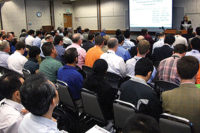Contractors hoping for a final word on the newest refrigerants will have to wait — but maybe only a bit longer.
Research continues at manufacturers and universities on the newest gases. Most of the studies are focusing on low-GWP HFCs and HFOs. But the good news is that what is currently being worked on could well represent the last generation of refrigerants.
At the most recent 15th International Refrigeration and Air Conditioning Conference at Purdue University (one of three concurrent conferences; the others dealing with compressors and high performance buildings), papers were presented at a session titled “Evaluating Alternative Refrigerants and Technologies.”
And even as those papers were being presented, Mark McLinden of the Applied Chemicals and Materials Division for the National Institute of Standards and Technology, used a plenary session to predict that what is being worked on now “is all there is….really. We are bumping up against the physical limits of the chemistry.”
Low Global Warming
A paper presented by Xudong Wang of the Air-Conditioning, Heating, and Refrigeration Institute (AHRI) updated conference attendees on AHRI’s Low Global Warming Potential Alternative Refrigerants Evaluation Program (Low-GWP AREP). At the time of the conference in mid-July, Wang said that 38 low-GWP refrigerants “were tested during the first phase in a variety of products including compressors, air conditioners, heat pumps, chillers, transport refrigeration, and ice makers. In addition, he said AHRI launched a second phase of testing in the beginning of 2014 that includes newly developed refrigerants and performance testing under high ambient conditions that were not covered in the first phase.” He noted the purpose was to identify potential replacements for high GWP refrigerants, but not to prioritize them.
Low Compressor Discharge Temperature
Barbara Minor of DuPont — speaking on behalf of a team from DuPont, Thermo King and Ingersoll Rand — addressed the issue of the high GWP of HFC-404A and the need for an alternative. She noted a development refrigerant presently called DR-34 (with a provisional ASHRAE designation of 452a). She described it as “a non-flammable refrigerant with low compressor discharge temperature similar to R-404A and closely matches all other properties and performance. This refrigerant will be particularly suitable for transport refrigeration where compressor cooling is difficult to manage under a wide range of ambient conditions.”
Finding the Right Replacement
The technical art of finding the best replacement for a high GWP refrigerant was shown in a paper presented by Radia Eldeeb on behalf of a team of researchers at the University of Maryland. They looked at three refrigerants currently being studied and defined as low GWPers in a 10.55 kW heat pump. One is HFC-32 (currently used in blends) while the other two are developmental refrigerants.
She said, “The test results show that HFC-32 is superior compared to R-410A in regards to cooling and heating capacities, while L41a is superior compared to R-410A in regards to COP, and D2Y60 is superior compared to R410A in regards to compressor discharge temperature. Generally, L41a is superior in terms of SEER and HSPF values compared to other alternative refrigerants.”
Low GWP in A/C
In looking at low GWP alternatives to both HCFC-22 and HFC-410A, Ankit Sethi reported on the progress that he and his colleagues have made at Honeywell International Inc. “Experimental results suggest that without significant system modifications, L-20 can match the performance of R-22 across the range of ambient temperatures observed in various countries in the Middle East. Hence, L-20 is a promising low global warming replacement for R22 in cooling-only systems designed to work in regions. Theoretical results indicate that in hydronic systems, L-20 would be expected to have reasonable efficiency with an operating envelope very similar to R-410A. Hence, L-20 seems to be an attractive R-410A replacement in hydronic systems.
“Preliminary evaluations of higher pressure and medium pressure blends also show promise in positive displacement chiller applications. However there are trade-offs in performance, flammability, and GWP that need to be made.”
HFOs
A report presented by Thomas Leck on behalf of colleagues at DuPont detailed some of the research regarding HFO refrigerants. He also presented a case for such research and how HFOs could end up working in stationary systems. (HFO-1234yf is already being used in automotive air conditioning.)
“In the interest of improved environmental sustainability, a new class of refrigerant molecule has been developed, the hydrofluoroolefin, or HFO. While the very low direct GWP values of these molecules are attractive, none of the HFOs by themselves are fully satisfactory for use in conventional stationary a/c system designs, for reasons of concern about low capacity and flammability. Blended refrigerant candidates have been developed to provide better overall safety and performance, while retaining significant environmental sustainability properties versus the legacy refrigerants.”











